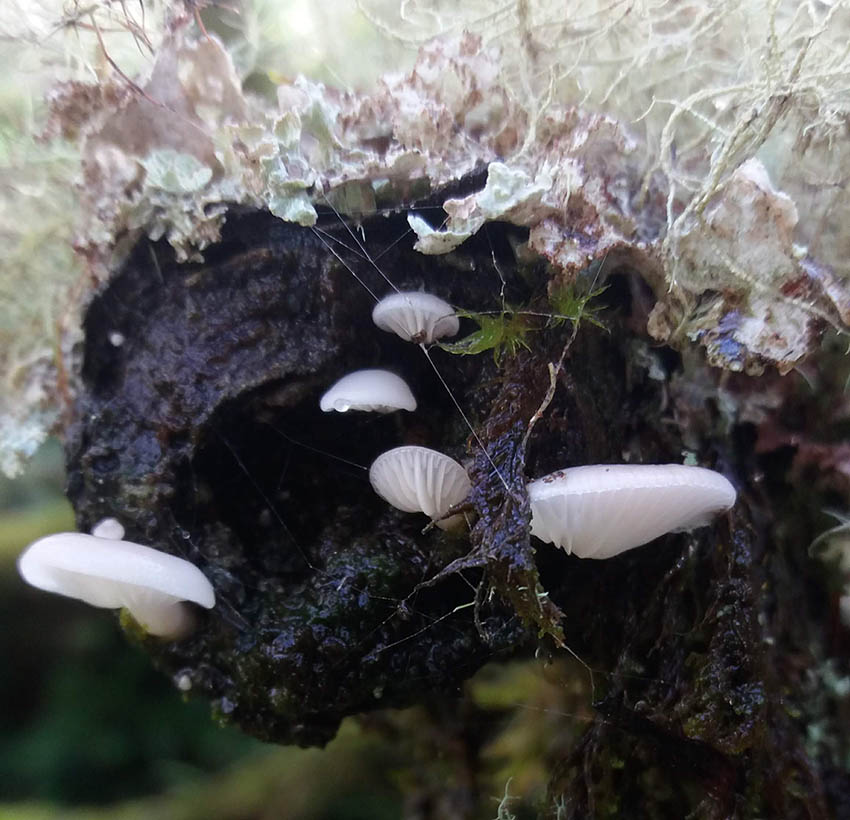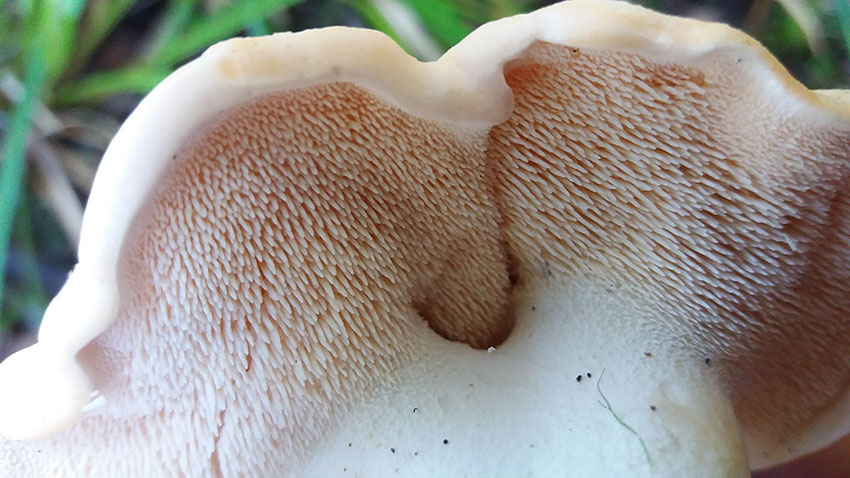(Photo: Tricholoma vaccinum at Boneyard Ridge. I will call it a fuzztopper. Looks like a perfect little felt hat.)
Photos and text by NCLC Land Steward Eric Owen
There is something special about the fall season. And while there is something special about every season and the transitions between them, I find a particular excitement about autumn. It’s more than one thing, actually. The cooling air temperatures, the darkening days, familiar birds migrating away and returning seasonal arrivals, the brilliantly changing colors of deciduous shrubs and trees (vine maple is a personal favorite).
But also, and especially, the abundance of weird and fascinating and delicious fungi that graces our forests and fields.

Extremely tiny white oysterettes (I believe) – Cheimonophyllum candidissimum – (try saying THAT three times fast!) on a log at Butte Creek Habitat Reserve.
The truth is, fungi are there year-round. But they become so much more apparent in the fall (and perhaps easier to overlook in the other seasons?). It seems most mushrooms do fruit in the fall, but they certainly can be found any time of year. You might just find different species during different times of the year.

Calocera cornea, a small stagshorn fungus, found at Boneyard Ridge Habitat Reserve.
To say that fungi are common would be an understatement. Ubiquity might better describe their prevalence. Most current literature says that between 80 and 90 percent of all plant species have symbiotic relationships with mycorrhizal fungi. Most of these are mutually beneficial, some are obligate, and many are parasitic. And while parasitic symbioses do harm to individual trees, they often help overall forest health by selecting weaker and diseased trees, leaving stronger and healthier individuals and thereby strengthening the overall forest composition.

Underside of a hedgehog (Hydnum repandum) at Neacoxie Forest Habitat Reserve. Note its soft, sweet spines (it is also known as the sweet tooth for its delectable flavor).
This is not, however, an essay on mycology and forest-fungi interactions (though I do find it utterly captivating), and I am not a mycologist (despite however much I pretend to be) so I’d better not digress any further. I mostly just want to share these countless little wonders that I stumble across, sometimes quite literally. (Earlier this month, while photopoint monitoring, I accidentally kicked a huge, frozen porcini and almost tripped over it.)

Turkey tail (Trametes versicolor) at Circle Creek Habitat Reserve.
For this blog post I started assembling the many photos I’ve taken this fall of cool fungi and lichens: entirely too many to choose.

The tiniest, most adorable red-belted conk (Fomitopsis pinicola) I’ve ever seen; that’s my pinky. Boneyard Ridge Habitat Reserve.
I narrowed it down to just mushrooms. Scratch lichens (sorry buddies!). Still too many! I decided to share only ones I’ve found on NCLC properties, and not those I have sought out or happened upon elsewhere. That’s 225 unique pictures in just the last two months. Maybe I’d better just look at November. But I still had more than 100 photos from this month alone. I chose my favorites: 50 remained. Maybe I’m a little too obsessed. At least it’s a healthy obsession.

Unknown species diffusing sunlight at Surf Pines Prairie Habitat Reserve. I suspect it’s in the russula family (Russulaceae).
In the meantime, enjoy the few photos I did select; they may not completely (or even remotely) capture the beauty, weirdness, uniqueness, diversity, and glory of all the fungi in our area, but it’s a glimpse. And at the very least, they’re fun to look at and try to identify.

Stunning violet corts (Cortinarius violaceus) at Boneyard Ridge. The photo really doesn’t do justice to their purpleness.
Comments